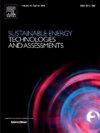PV-ETICS和深色外墙的室内过热风险:基于实验和模拟的评估
IF 7
2区 工程技术
Q1 ENERGY & FUELS
Sustainable Energy Technologies and Assessments
Pub Date : 2025-07-18
DOI:10.1016/j.seta.2025.104452
引用次数: 0
摘要
建筑集成光伏(BIPV)因其改善能源性能和现场发电而受到关注。然而,外墙应用中的深色光伏板可能会造成过热的风险,特别是当集成到没有通风腔的外部隔热复合系统(ETICS)中时。本研究调查了爱沙尼亚寒冷气候下深色立面抹灰和带有外部相变材料(PCM)的BIPV对室内过热的影响。用PV-ETICS和浅色传统ETICS构建了一个全尺寸的实验测试墙,并对其热行为进行了监测。建立了IDA ICE仿真模型并进行了标定。利用该模型对一栋典型的混凝土公寓楼进行了过热分析。结果表明,在保温层厚度为200 mm的情况下,PV-ETICS系统在27°C以上仅略微增加了3-10°C·h的过热度-小时,而保温层厚度较薄的材料则表现出更明显的过热。虽然过热效应并不严重到足以阻碍PV-PCM ETICS立面概念,但在室内气候和能源建模中应该考虑到这一点,特别是对于绝缘水平≤100 mm的情况。可以通过使用较低g值的玻璃或被动式遮阳方法来实现缓解。本文章由计算机程序翻译,如有差异,请以英文原文为准。
Indoor Overheating Risks of PV-ETICS and Dark-coloured Facades: Experimental and Simulation-based Assessment
Building-integrated photovoltaics (BIPV) are gaining attention for improving energy performance and on-site electricity generation. However, dark-coloured PV panels in facade applications may pose a risk of overheating, particularly when integrated into External Thermal Insulation Composite Systems (ETICS) without a ventilation cavity. This study investigates the impact of dark facade plasters and BIPV with external phase change materials (PCM) on indoor overheating in the cold climate of Estonia. A full-scale experimental test wall with PV-ETICS and light-coloured traditional ETICS was constructed and monitored for thermal behaviour. An IDA ICE simulation model was created and calibrated. Using this model, a typical concrete apartment building was analysed for overheating. The results showed that PV-ETICS systems only modestly increased overheating degree-hours — by 3–10 °C·h above 27 °C in the case of a 200 mm thermal insulation layer, while thinner insulations showed more significant overheating. While the overheating effect isn’t severe enough to hinder the PV-PCM ETICS facade concept, it should be considered in indoor climate and energy modelling, especially for insulation levels ≤100 mm. Mitigation can be achieved by using lower g-value glazing or passive shading methods.
求助全文
通过发布文献求助,成功后即可免费获取论文全文。
去求助
来源期刊

Sustainable Energy Technologies and Assessments
Energy-Renewable Energy, Sustainability and the Environment
CiteScore
12.70
自引率
12.50%
发文量
1091
期刊介绍:
Encouraging a transition to a sustainable energy future is imperative for our world. Technologies that enable this shift in various sectors like transportation, heating, and power systems are of utmost importance. Sustainable Energy Technologies and Assessments welcomes papers focusing on a range of aspects and levels of technological advancements in energy generation and utilization. The aim is to reduce the negative environmental impact associated with energy production and consumption, spanning from laboratory experiments to real-world applications in the commercial sector.
 求助内容:
求助内容: 应助结果提醒方式:
应助结果提醒方式:


